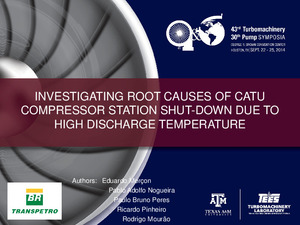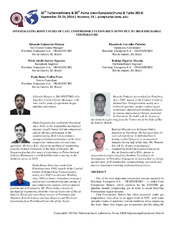Investigating Root Causes of Catu Compressor Station Shut-Down Due to High Discharge Temperature
Investigating Root Causes of Catu Compressor Station Shut-Down Due to High Discharge Temperature (Supplemental Material)
| dc.contributor.other | Turbomachinery Symposium (43rd : 2014) | |
| dc.creator | Merçon, Eduardo | |
| dc.creator | Nogueira, Pablo Adolfo | |
| dc.creator | Peres, Paulo Bruno | |
| dc.creator | Pinheiro, Ricardo | |
| dc.creator | Mourão, Rodrigo | |
| dc.date.accessioned | 2017-09-22T20:32:15Z | |
| dc.date.available | 2017-09-22T20:32:15Z | |
| dc.date.issued | 2014 | |
| dc.identifier.uri | https://hdl.handle.net/1969.1/162725 | |
| dc.description | Case Study | en |
| dc.description.abstract | One of the most important compressor stations operated by Petrobras Transporte S.A. – TRANSPETRO – is called Catu Compressor Station, which operates for the GASENE gas pipeline, usually compressing gas in order to attend Brazilian Northeastern region demand. Catu Compressor Station has often presented outlet gas temperatures very close to its upper limit of 50ºC, with some sporadic events of automatic station shutdown when surpassing this limit. Since they began, gas temperature profiles along the Catu compression process have been monitored and investigated. Depending on the pipeline flow direction and demand, this marginal operation could impact directly on the station’s compression versatility. Possible causes for this high outlet gas temperature problem are presented through a “fishbone” analysis, leading to a master action plan. This plan mainly comprehended the analysis and check of design data and operational parameters of the centrifugal compressors and its downstream process heat exchangers, culminating in field tests to submit this equipment to the highest possible range of operational conditions. Despite the difficulties, mainly for field test accomplishment, the master plan revealed an incompatibility between the current operating profile of Catu compressors and the design thermal capacity of its heat exchangers. To better support this find and predict the possible operational limits, a compression process modelling effort was conducted utilizing dynamic process simulation. The simulation results showed the limitation extension imposed on the compressor’s operational envelope by its heat exchanger capacity, for a variety of operational conditions, such as different environmental and process gas temperatures. Finally, options for mitigating and solving the presented operational limitation are proposed and discussed. | en |
| dc.format.medium | Electronic | en |
| dc.format.mimetype | application/pdf | |
| dc.language.iso | en | |
| dc.publisher | Texas A&M University. Turbomachinery Laboratories | |
| dc.relation.ispartof | Proceedings of the 43rd Turbomachinery Symposium | en |
| dc.subject.lcsh | Turbomachines | en |
| dc.title | Investigating Root Causes of Catu Compressor Station Shut-Down Due to High Discharge Temperature | en |
| dc.title | Investigating Root Causes of Catu Compressor Station Shut-Down Due to High Discharge Temperature (Supplemental Material) | en |
| dc.type.genre | Presentation | en |
| dc.type.material | Text | en |
| dc.identifier.doi | https://doi.org/10.21423/R1TD17 |



